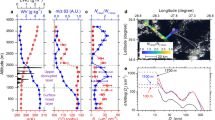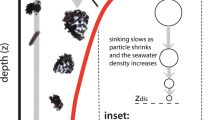Abstract
There is increasing evidence that the deposition of atmospheric participate material has a significant influence on the chemistry of trace elements in many oceanic regions1–4. One significant but unknown parameter is the efficiency of in-cloud and below-cloud scavenging processes as a function of aerosol particle size. Studies in continental regions have indicated that the largest particles are scavenged most efficiently by rain5. We report here, for the first time, an evaluation of particle scavenging by tropical showers, based on data obtained at Eniwetok Atoll and American Samoa in the tropical Pacific Ocean. We find no clear evidence of a particle size dependence for scavenging in this remote marine region. This indicates that estimates of global atmospheric deposition over the ocean based on extrapolation of measurements made on land may be invalid.
This is a preview of subscription content, access via your institution
Access options
Subscribe to this journal
Receive 51 print issues and online access
$199.00 per year
only $3.90 per issue
Buy this article
- Purchase on Springer Link
- Instant access to full article PDF
Prices may be subject to local taxes which are calculated during checkout
Similar content being viewed by others
References
Cambray, R. S., Jeffries, D. F. & Topping, G. U.K. atom. Energy author. Publ. no. AERE-R7733 (HMSO, London, 1975).
Buat-Menard, P. & Chesselet, R. Earth planet. Sci. Lett. 42, 399–411 (1979).
Settle, D. M. & Patterson, C. C. J. geophy. Res. 87, 8857–8869 (1982).
Arimoto, R., Duce, R. A., Ray, B. J. & Unni, C. K. J. geophys. Res. 90, 2391–2408 (1984).
Scott, B. C. Atmospheric Pollutants in Natural Waters (ed. Eisenreich, S. J.) 3–21 (Ann Arbor Science, 1981).
Uematsu, M., Duce, R. A. & Prospero, J. M. J. atmos. Chem. 3, 123–138 (1985).
Duce, R. A., Arimoto, R., Ray, B. J., Unni, C. K. & Harder, P. J. J. geophys. Res. 88, 5321–5342 (1983).
Buat-Menard, P., Ezat, U. & Gaudichet, A. Precipitation Scavenging, Dry Deposition and Resuspension Vol. 2, 1259–1270 (Elsevier, New York, 1983).
Gatz, D. F. Precipitation Scavenging—1974 (eds Beadle, R. W. & Semonin, R. G.) 71–87 (U.S. Energy Res. Dev. Ag., Washington, DC, 1975).
Cawse, P. A. U.K. atom. Energy Auth. Publ. no. R7669 (HMSO, London, 1974).
Duce, R. A. et al. in Abstr. IAMAP/CACGP Symp. Budget and Cycles of Trace Gases and Aerosols in the Atmosphere (University of Colorado Press, Boulder, 1979).
Slinn, W. G. N. Air-Sea Exchange of Gases and Particles (eds Liss, P. S. & Slinn, W. G. N.) 299–405 (Reidel, Dordrecht, 1983).
Blanchard, D. C. & Woodcock, A. H. Ann. N.Y. Acad. Sci. 338, 330–347 (1980).
Delaney, A. C., Pollock, W. H. & Shedlovsky, J. P. J. geophys. Res. 78, 6249–6268 (1973).
Gillette, D. A. & Blifford, I. H. J. atmos. Sci. 28, 1199–1210 (1971).
Gwinn, E. & Sarmiento, J. L. A Model for Predicting Strontium-90 Fallout in the Northern Hemisphere (1954–1974) (Ocean Tracers Lab., Princeton University, 1984).
Sarmiento, J. L. & Gwinn, E. J. geophys. Res. (in the press).
Author information
Authors and Affiliations
Rights and permissions
About this article
Cite this article
Buat-Ménard, P., Duce, R. Precipitation scavenging of aerosol particles over remote marine regions. Nature 321, 508–510 (1986). https://doi.org/10.1038/321508a0
Received:
Accepted:
Issue Date:
DOI: https://doi.org/10.1038/321508a0
This article is cited by
-
The sources of trace element pollution of dry depositions nearby a drinking water source
Environmental Science and Pollution Research (2017)
-
Estimation of the temporal and spatial distribution of dust concentration over China by combining PM10 and conventional meteorological observations
Environmental Monitoring and Assessment (2010)
-
Size Distribution of Trace Elements and Major Ions in the Eastern Mediterranean Atmosphere
Water, Air, and Soil Pollution (2005)
-
Preliminary investigations on7Be as a tracer in the study of environmental processes
Journal of Radioanalytical and Nuclear Chemistry Articles (1995)
-
Particulate carbon content in rain at various temperate and tropical locations
Journal of Atmospheric Chemistry (1992)
Comments
By submitting a comment you agree to abide by our Terms and Community Guidelines. If you find something abusive or that does not comply with our terms or guidelines please flag it as inappropriate.



